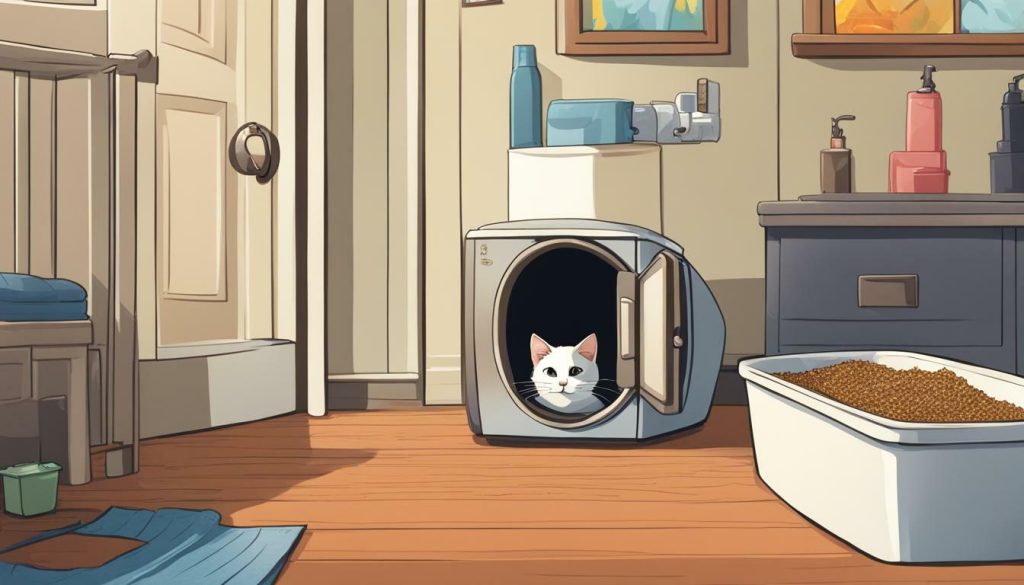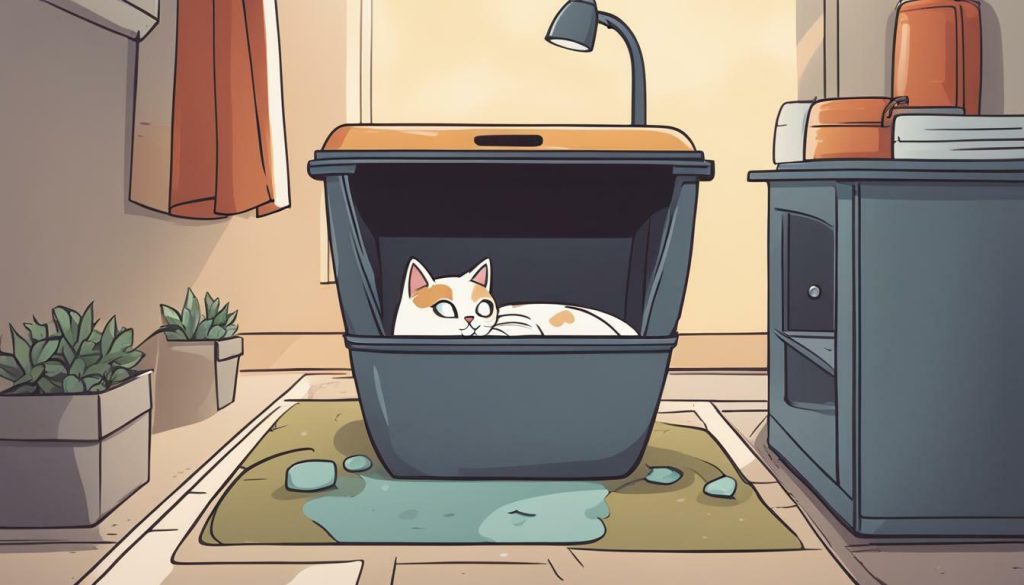As a pet owner, few things are more frustrating than finding cat poop on the floor instead of in the litter box. It’s a common problem that many cat owners have to deal with, but why do cats do this? Understanding the reasons behind this behavior can help you find a solution to the issue and create a cleaner environment for you and your feline friend.
In this section, we’ll explore the potential reasons why your cat may be pooping on the floor instead of using their litter box. We’ll also provide some tips on how to manage this behavior and promote proper bathroom habits in your cat.
- 1 Key Takeaways:
- 2 Understanding Cat Toilet Habits
- 3 Common Reasons for Cats Pooping on the Floor
- 4 Medical Conditions and Cat Poop Accidents
- 5 Preventing Cats from Pooping on the Floor
- 6 Litter Box Training Tips and Techniques
- 7 Seeking Professional Help for Stubborn Cases
- 8 Conclusion
-
9
FAQ
- 9.1 Q: Why do cats poop on the floor?
- 9.2 Q: How can I understand my cat’s bathroom habits?
- 9.3 Q: What are the common reasons for cats pooping on the floor?
- 9.4 Q: Can medical conditions cause cat poop accidents?
- 9.5 Q: How can I prevent cats from pooping on the floor?
- 9.6 Q: How can I litter box train my cat?
- 9.7 Q: When should I seek professional help for litter box problems?
Key Takeaways:
- Why do cats poop on the floor?
- Understanding cat litter box problems
- Identifying common reasons for cats pooping on the floor
- Preventing cats from pooping on the floor
- Litter box training tips and techniques
Understanding Cat Toilet Habits
Before we can address the issue of cats pooping on the floor, it’s crucial to understand their natural bathroom habits. As a cat owner, it’s essential to interpret your feline’s body language and vocalizations to comprehend their needs.
Cats have an instinctive preference for eliminating in a clean and private area. They prefer to dig and bury their feces, which is a natural behavior inherited from their wildcat ancestors. Additionally, cats have a superior sense of smell, and they tend to avoid heavily scented litter boxes or areas with strong odors.
Disruptions to a cat’s routine or environment can cause litter box issues. For example, cats may stop using their litter box if it’s too dirty or if they don’t like the type of litter you’re using. Cats may also develop aversions to specific locations based on previous negative experiences or if they feel unsafe in that area.
It’s also worth noting that cats are solitary creatures, and they may become anxious or stressed if they don’t have a designated bathroom area. If there are multiple cats in the household, it’s essential to provide each cat with its litter box to avoid competition and minimize stress.
As a cat owner, it’s essential to pay attention to your cat’s bathroom behavior to recognize any changes or abnormalities. Do they seem to be straining to eliminate, or are they crying out in pain? These could be signs of a medical issue that requires immediate attention.
Understanding your cat’s natural toilet habits is the first step in addressing litter box issues. By providing a clean and comfortable environment, cats can eliminate their waste without stress or discomfort.
Common Reasons for Cats Pooping on the Floor
So, why is your cat pooping on the floor instead of using their litter box? There are several common reasons for this behavior, and understanding them is crucial to finding a solution.
First, inadequate litter box cleanliness can turn your cat off from using the litter box. Cats are naturally clean creatures and prefer a tidy bathroom environment. Ensure that you’re scooping the litter box at least once a day and doing a full litter replacement once a week.
Second, location is important. If the litter box is in an area that your cat doesn’t feel comfortable in or is difficult to access, they may choose to eliminate elsewhere. Try moving the litter box to a more secluded and quiet area of the house and ensure that it’s easily accessible to your feline friend.
Third, cats may poop on the floor due to underlying medical issues such as gastrointestinal problems or urinary tract infections. If you suspect that this may be the case, consult with your veterinarian to rule out any health concerns.
Fourth, stress can play a significant role in litter box problems. Cats are creatures of habit and routine disruptions can trigger unwanted behavior. Consider whether any changes in your cat’s environment, such as a new pet or a move to a new house, may be causing stress.
Fifth and finally, territorial marking may also be a factor. If you have multiple cats, ensure that each cat has their own litter box and that they’re not placed too closely together. Cats can be very particular about their territory.
By understanding these common reasons for litter box problems, you can start to identify the root cause of your cat’s behavior and take steps to address it.
“Understanding your cat’s needs and providing the right environment, you can help ensure a clean and happy bathroom experience for both you and your feline friend.”
Medical Conditions and Cat Poop Accidents
As I mentioned earlier, sometimes cats may have accidents outside the litter box due to underlying medical conditions. It’s essential to rule out any health concerns before addressing the behavioral issues.
If your cat is experiencing diarrhea, constipation, or incontinence, it could indicate gastrointestinal problems. Urinary tract infections and bladder stones can also cause cats to pee outside the litter box. Even arthritis can make it difficult for cats to climb into the litter box, leading to accidents.
If you suspect your cat is experiencing medical issues, take them to the vet immediately. Your vet may prescribe medication or suggest dietary changes to address the problem. Remember, addressing health issues is crucial for your cat’s overall well-being, and can also help with litter box problems.
Once you have ruled out medical problems, you can focus on addressing any behavioral issues that may be contributing to your cat’s litter box problems. In the next section, we’ll explore the best strategies for preventing cats from pooping on the floor.
Preventing Cats from Pooping on the Floor
If you’re tired of cleaning up after your cat’s bathroom accidents, you’re not alone. Preventing cats from pooping on the floor requires some effort and patience, but it’s worth it in the end. Here are some tips to help you prevent cat litter box problems:
Litter Box Placement
Choosing the right location for your cat’s litter box can make a big difference. Cats prefer a quiet and private space, away from high-traffic areas. Choose a spot that’s easily accessible to your cat, but not in a noisy or stressful area. Consider placing the litter box on each floor of your home, so your cat always has easy access to one nearby.
Litter Box Cleanliness
Cleanliness is key when it comes to preventing cat litter box problems. Cats are clean animals, and they prefer a clean litter box. Scoop the box at least once a day, and replace the litter entirely every week. Use unscented, clumping litter, and avoid harsh chemicals or strong fragrances that may deter your cat from using the box.
Litter Box Size and Type
Make sure your cat’s litter box is big enough for them to move around comfortably. A general rule of thumb is that the box should be at least one and a half times the length of your cat. If you have a large cat, consider getting a larger litter box. Additionally, some cats may prefer a specific type of litter box, such as one with a lid or one that’s self-cleaning. Experiment with different types to see what your cat prefers.
Environmental Enrichment
Environmental enrichment can help reduce stress and encourage proper bathroom habits in cats. Provide your cat with plenty of toys, scratching posts, and hiding spaces, and spend quality time playing with them every day. Consider setting up a feeding routine and providing a variety of food puzzles to keep their minds and bodies engaged.
By following these tips, you can help prevent cat litter box problems and ensure a happy and healthy cat. Remember to be patient and consistent with your efforts, and consult with a veterinarian if you suspect any underlying medical issues.
Litter Box Training Tips and Techniques
If your cat is not using the litter box consistently, don’t get discouraged. Litter box problems are common among cats, and with a little patience and training, most cats can learn to use the litter box properly.
Litter box training should always be positive and never involve punishment.
First, ensure that your cat is healthy and not experiencing any medical issues that may contribute to litter box problems. Once cleared by a veterinarian, it’s time to start training.
Here are the steps to follow:
- Choose the right litter box: look for one that is large enough for your cat to comfortably turn around and that has low sides for easy entry and exit.
- Choose the right litter: opt for unscented, clumping litter that your cat is comfortable using.
- Place the litter box in a quiet, accessible location: somewhere that your cat can easily find and use. Avoid placing it next to appliances like washing machines or dryers, as they may startle your cat and discourage litter box use.
- Show your cat where the litter box is: gently place your cat in the litter box so they can explore it on their own.
- Encourage your cat to use the litter box: when you notice your cat sniffing around or preparing to eliminate, gently pick them up and place them in the litter box. You can also try using a verbal cue like “go potty” to associate the behavior with the litter box.
- Reward your cat for using the litter box: offer praise and treats when your cat uses the litter box successfully. Positive reinforcement is key to litter box training.
- Keep the litter box clean: scoop the litter box at least once a day, and replace the litter entirely every 2-3 weeks.
- Gradually expand your cat’s territory: once your cat is regularly using the litter box, you can start giving them more space to roam around the house. Do this gradually and monitor their behavior to ensure continued litter box use.
Remember that litter box training takes time and consistency. If you’re having trouble, consult with your veterinarian or a cat behaviorist.
Seeking Professional Help for Stubborn Cases
If you’ve tried various strategies to address your cat’s litter box problems, but still find yourself dealing with persistent accidents, it may be time to seek professional help. While many issues can be solved with simple changes to the litter box environment, some cats may require more specialized attention.
If your cat has a medical condition that is contributing to the behavior, a veterinarian can help diagnose and treat the problem. Additionally, a cat behaviorist can work with you to identify any underlying issues that may be causing your cat’s litter box aversion.
It’s important to remember that every cat is unique and may require a customized approach. Seeking professional help can provide valuable insights and guidance to help you and your cat overcome litter box problems and restore harmony to your home.
Conclusion
In conclusion, dealing with litter box problems can be frustrating, but it’s important to approach the situation with patience and understanding. By taking the time to understand your cat’s behavior and needs, you can address the root cause of their accidents and help them develop proper bathroom habits.
Remember to keep your cat’s litter box clean, accessible, and appropriately sized for their needs. Consider providing environmental enrichment like scratching posts, toys, and perches to reduce stress and encourage proper elimination behavior.
If your cat continues to have accidents outside the litter box, it may be necessary to seek professional help from a veterinarian or specialized cat behaviorist. With their expertise, they can identify any underlying medical or behavioral issues and develop a customized plan to help your cat feel comfortable and confident using their litter box.
Overall, with a little patience and dedication, you can create a happy and healthy bathroom environment for both you and your feline friend.
FAQ
Q: Why do cats poop on the floor?
A: Cats may poop on the floor for various reasons, including litter box cleanliness, location preferences, medical conditions, stress, and territorial marking.
Q: How can I understand my cat’s bathroom habits?
A: Understanding your cat’s natural toilet habits is crucial in addressing litter box problems. We’ll explore their instincts and how disruptions to their routine or environment can contribute to this behavior.
Q: What are the common reasons for cats pooping on the floor?
A: Common reasons include litter box cleanliness, location preferences, medical conditions, stress, and territorial marking. Identifying these factors will help determine the root cause of your cat’s behavior.
Q: Can medical conditions cause cat poop accidents?
A: Yes, underlying medical issues such as urinary tract infections, gastrointestinal problems, and arthritis can lead to cats pooping on the floor. It’s important to rule out any health concerns before addressing behavioral issues.
Q: How can I prevent cats from pooping on the floor?
A: Strategies to prevent this behavior include proper litter box placement, cleanliness, size, and type. Additionally, environmental enrichment techniques can help reduce stress and encourage proper bathroom habits.
Q: How can I litter box train my cat?
A: If your cat is not using the litter box consistently, retraining may be necessary. We’ll provide step-by-step instructions on litter box training techniques, including positive reinforcement, proper set-up, and gradual reintroduction to the litter box.
Q: When should I seek professional help for litter box problems?
A: If your cat’s litter box problems persist despite your efforts, it may be appropriate to consult with a veterinarian or a specialized cat behaviorist. They can identify underlying issues and create a customized plan to address your cat’s specific needs.















